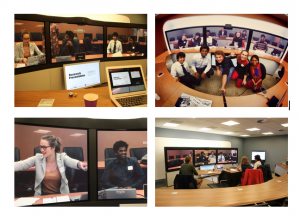On a chilly February morning in Amsterdam, as we bid goodbyes after meeting in MediaLAB Amsterdam, the conversation drifted, as it usually does, to the most interesting parts of the discussion – while newspapers debate over women’s safety in public spaces, can we think of designing options to enhance a sense of security? How about a wearable panic button? Something that could be an accessory, like a pendant or a ring?
It was this idea that seeded a cross-cultural collaborative effort between MediaLAB Amsterdam (Amsterdam University of Applied Sciences) and Fields of View Bangalore (IIIT-B) to design options for safety of women in public spaces. MediaLAB Amsterdam is a creative, interdisciplinary studio where students and researchers work together on innovative and interactive media research projects for Creative Industries. Fields of View is a research lab at IIIT-B, India with an interest in developing communication tools and serious games to enhance and facilitate learning, participatory processes and decision making regarding Urban Systems and Public Safety and Security
Beginning September 2013, two teams, one in Amsterdam and the other in Bangalore began researching safety of women in public spaces in their respective cities for the next 20 weeks in order to design options to enhance safety.
The Women’s Safety project would constitute the first phase of a large effort: Design Across Cultures, a research project made possible by the Amsterdam Creative Industries Center of Expertise and project partner Cisco Systems.
In this white paper, we aim to explore and ponder over what we learned and what challenged us in this cross-cultural design effort. We will discuss what worked, what could have been done better in terms of the processes followed, both in designing and for designing. We will take three aspects of the research – context; problem definition and design process; and the team, and discuss in each of those the differences, what we learned and challenges.
We hope this white paper would benefit those working on other such cross-cultural projects, and researchers interested in ethnography of designing.
2e versie_White paper cross cultural collaboration 2013 – Google Drive


